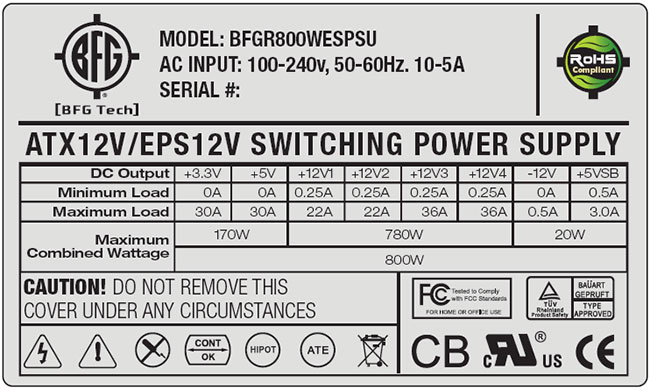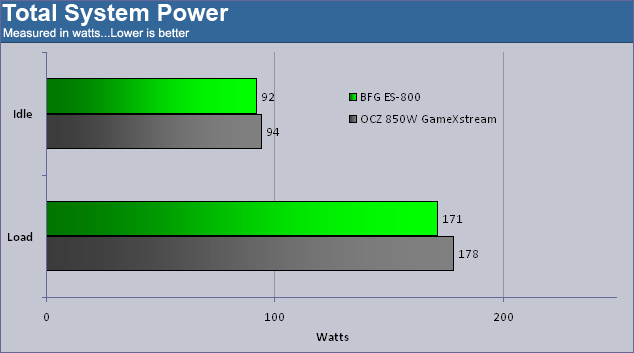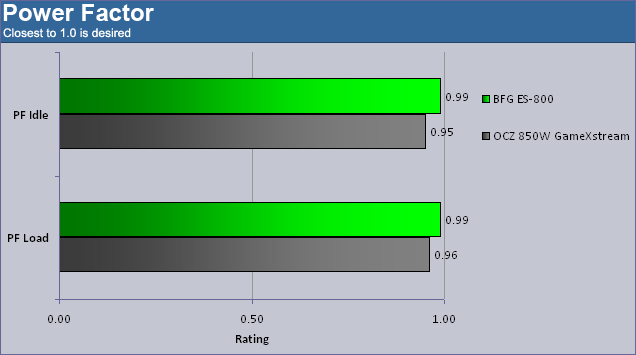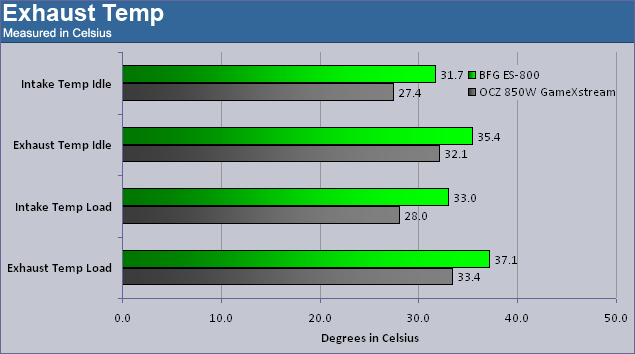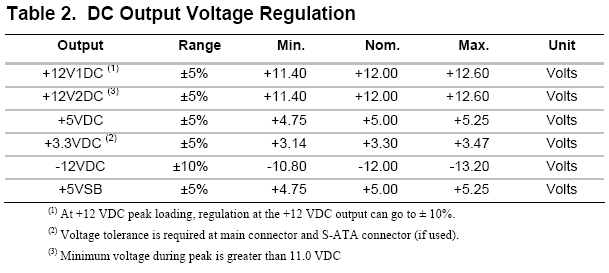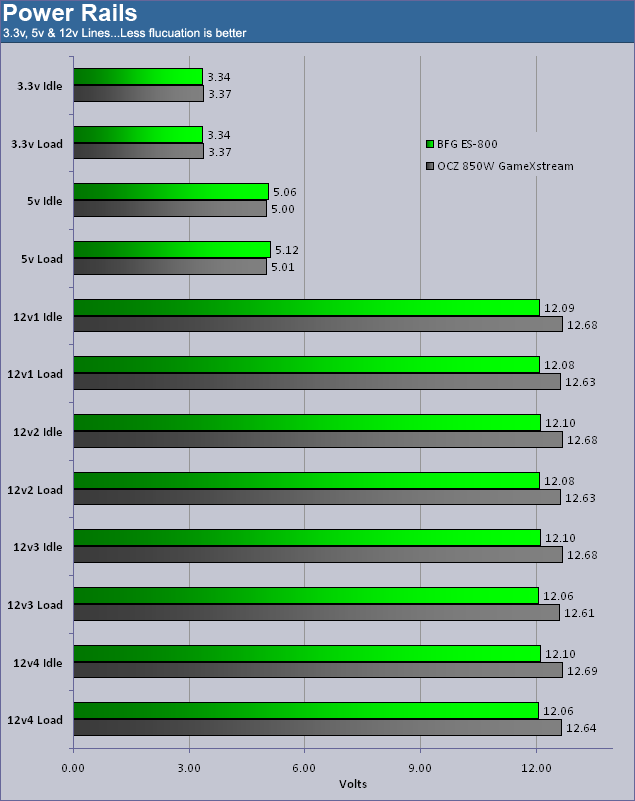BFG, known for making some of the best motherboards and video cards around, is here to show you their greener side. The ES-800 is BFG’s answer to greener computing at any power level. Read on to find out if this PSU is worthy of a home in your next build.
INTRODUCTION
The power supply is an odd component of sorts. In the same way our heart doesn’t make us run faster or get better grades in school, a power supply won’t give you a higher frame rate or make your CPU faster. But without a strong, solid heart even everyday tasks would become difficult. Imagine trying to walk a flight of stairs with a weak heart or carry groceries. Your power supply is the heart, the very core, of your PC and without a strong solid PSU everyday tasks become difficult. Imagine trying to play games or run Folding@Home with a flaky PSU. Constant lock-ups or total shut-downs would put a quick stop to any chance of enjoyment you would get from your PC. Clean, solid power is a must in today’s PCs but with so many poor quality power supplies masquerading as high-end units it’s easy to get buried by the sea of marketing hype. Today Bjorn3D is looking at one power supply that not only positions itself as a top-notch PSU built with quality components, but brings some new tricks to the table to increase efficiency and show some love to mother earth. The power supply is the ES-800 by BFG. A company well known for its commitment to quality. Let’s put some of BFG’s claims to the test and see if this unit is worthy of your hard earned money.

FEATURES & SPECIFICATIONS
Features
- Active PFC (Power Factor Correction)
- ATX12V 2.2 / EPS12V 2.91
- 80+ Certified
- Quad +12V Rails
- Extra long cables support full tower size chassis
- Silent 138mm Intake Fan
- 800W Continuous Rated at 40°C
Connectors
To view a larger image of each connector click the image.
With no shortage of connectors to be found you can trust that this unit will handle all of your hardware. Now let’s take a quick look at how the power is broken down in this beast.
Specifications
|
BFG ES-800 Watt PSU |
||
| AC Input Rating | 100 – 240VAC | |
| Input Current | 5 – 10A | |
| Frequency | 50Hz – 60Hz | |
| Output Voltage | Max Load | Max Output |
| +3.3V | 30 Amps | 170W |
| +5V | 30 Amps | |
| +12V1 | 22 Amps | 780W |
| +12V2 | 22 Amps | |
| +12V3 | 36 Amps | |
| +12V4 | 36 Amps | |
| -12V | 0.5 Amps | 20W |
| +5Vsb | 3.0 Amps | |
| Total Power | 800W | |
| Power Factor | 0.99 Typical | |
| Dimensions | 150mm(W) x 165mm(L) x 86mm(H) | |
There is one thing these specs don’t reveal and it’s one of the most important parts. Not only can the ES-800 deliver up to 800w of environmentally friendly power, but it can do so at temperatures up to 40ºC! For my American brothers and sisters that means 104º F. Wow. Most PSU manufactures rate their PSUs at only 25-30º C (77-86ºF) which can easily be exceeded on hot summer days.
FREQUENCY CONVERSION
One of the biggest selling points to the BFG ES-800 is a little thing called frequency conversion. BFG claims “the ES-800 power supply can actually emulate virtually any size power supply up to 800W and therefore be at least 80% efficient, even with loads as low as 10% of the unit’s maximum capability.” This certainly sounds promising since most power supplies hit their peak efficiency between 40% – 60% of the rated maximum load. This means more work for you as it would make sense to know how much power you’ll be using before selecting the right PSU for you. If your power usage changes then the efficiency of the PSU make decrease as a result. This certainly makes BFG’s claims all the more appealing. It basically means with this PSU you can use it on a less power hungry machine and as you upgrade, the PSU will continue to perform at its peak efficiency saving you money. So what is frequency conversion?
Frequency conversion is the result of an electronic device that converts alternating current of one frequency to alternating current of another frequency. The device may also change the voltage. If voltage conversion is desired, a transformer will usually be included in either the ac input or output circuitry. This is what allows the ES-800 to maintain is peak efficiency. It is an ingenious idea and one that we intend to pick apart to see just what sort of impact it has.
PHOTOS
The first pictures show us the packaging BFG selects to keep the ES-800 safe. The rear of the box is what caught my attention. The graphs are a nice touch but its the section telling you how ‘Upgrading your PSU is simple!’ is what I am focusing on. Why? Look closely at the directions. Nowhere in these simple instructions does it tell you to unplug your PSU from the wall and turn it to the off position. It may seem obvious to those of you reading this but for the people out there who read the back of the box to help them get through installing this PSU, this could be hazardous. Remember BFG, a live customer is always better than a dead one.
Click a picture to see a larger view
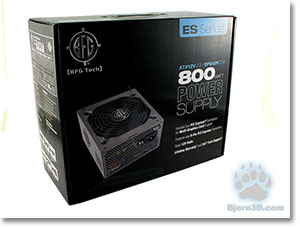 |
 |
| Box Front | Box Back |
The first photo below shows us the rear grill and the on/off switch. BFG uses the on/off labeling so new users don’t get confused by the 1/0 switch. (1 = ON / 0 = OFF) The next photo shows us the 138mm fan. Yup I said 138mm, not 140mm or 135mm. Odd sizes aside I found this fan to perform exceptionally well and could not make out any fan noise during testing. This is surprising considering we have a very quiet testing environment making it easy to distinguish any noise offenders. Kudos to BFG for their selection of fans.
Click a picture to see a larger view
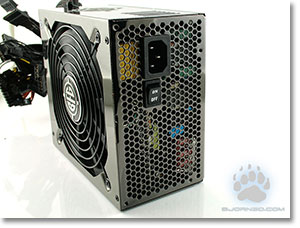 |
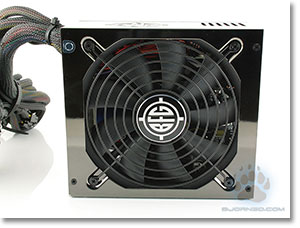 |
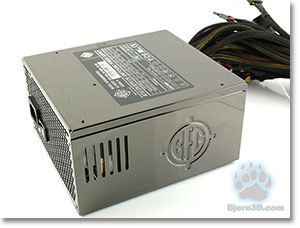 |
 |
The last two photos above show off the attention to detail BFG has paid the ES-800. No matter how you install this PSU, the stamped logo will always sit upright ready to be shown off to your friends. With this sort of attention to detail, you had better take care of some other details like performance and efficiency. Otherwise it is just a distraction.
BUILD QUALITY
Looking at the components of the power supply it is a straight forward setup. Inside we find the following items:
- Smoothing Capacitors – When we get DC rectified from AC, we find that the voltage is far from steady. Since electronic circuits need to have steady voltages, smoothing of the rectified AC is accomplished with this capacitor.
- Power Transformer – Computers require six different voltages to operate (+12v, +5v, +3.3v, -5v, -12v, and +5v of the standby mode). Because it’s not possible to pack two independent high-power regulators into a power supply, this component creates the various voltages required.
- Output Wires – These are the wires that connect the various components of your PC to the power supply.
- +5vsb Power Supply – Rather than derive the +5vsb from the main transformer, BFG has installed a separate PCB in the ES-800 for the +5v line. All other voltages are delivered from the main unit.
The ES-800 is comprised of a 450v 150uF Nippon Chemi-con primary cap (secondary caps are all Nippon Chemi-con) for its main unit and a Hitachi 560uF 450v cap for the +5vsb side. Overall the ES-800 is built with high quality components in a manner that breaks away from conventional design. How well this departure performs remains to be seen, so without further ado its time to start testing.
TEST SETUP – LOW POWER
For our first test we are going to jump right into BFG’s claims of efficiency at loads as low as 10%. Now while we do not have a dedicated load tester what we are going to do today is compare the BFG ES-800 to the OCZ 850w GameXstream at each level of power consumption and see how the ES-800 handles itself.
We are going to look at total system wattage consumed, power factor, temperatures of the air at both the intake side and exhaust side and then finally we will measure the voltage of each line using a digital multi meter.
Here is our low power machine setup.
| Test Platform | |
| Processor | Intel Core 2 Quad e6420 @ 2.1 GHz (1.25v) |
| Motherboard | ASUS X38 Maximus Formula (DDR2) |
| Memory | 1 GB (2 x 512 MB) Corsair DDR2-800 |
| Drive(s) | 1 – Seagate 80GB Barracuda SATA |
| Graphics | Albatron 8600GTS |
| Sound | Sound Blaster 2 ZS |
| Cooling | Thermaltake Big Typhoon |
| Power Supply | PSU 1 – OCZ GameXStream 850 watts PSU 2 – BFG ES-800 |
| Display | Westinghouse 37″ LVM-37W3 |
| Case | No case |
| OS | Windows XP SP3 |
To test the amount out wattage consumed and power factor rating we will be using a Kill-A-Watt power meter. To test the voltages across the various rails we will be using a digital multimeter.
Total Wattage Consumed
This measurement is of the entire PC sans monitor. Idle measurement is taken after a fifteen minute period of inactivity. Load is measured after running four instances of Prime95 – small FFTs and looping 3DMark06 to load up the GPU.
We went low, very low with power consumption. At idle our PC uses less power than some household fans. Our load level is pretty green too considering the type of stress we are applying. This level of stress is rare since we are simultaneously pushing the CPU and GPU to the max. Even so, the ES-800 starts out strong and chews up two less watts at idle and seven less at full load.
What I did find odd was that at such a low power level like we have at idle the numbers between the two units are so close. Most power supplies have a bell curve when it comes to efficiency that peaks right around 50% load. This means at lower levels they are not as efficient and should use more power. Also, the BFG ES-800 uses frequency conversion to mimic any size power supply up to 800watts to give it a great level of efficiency where the OCZ 850watt PSU doesn’t have the technology employed, yet manages to come very close at this low power level.
Power Factor
From Wikipedia:
The power factor of an AC electric power system is defined as the ratio of the real power to the apparent power, and is a number between 0 and 1. Real power is the capacity of the circuit for performing work in a particular time. Apparent power is the product of the current and voltage of the circuit. Due to energy stored in the load and returned to the source, or due to a non-linear load that distorts the wave shape of the current drawn from the source, the apparent power can be greater than the real power. Low-power-factor loads increase losses in a power distribution system and result in increased energy costs.
Big differences here as the BFG ES-800 just breezes through with an almost perfect power factor score. The OCZ has trouble at this extremely low power level and as such won’t be able to convert the apparent power into real power as described above.
Temps
We use a digital probe on the intake side of the PSU and another one at the exhaust side of the PSU to measure the temps. This will give us an idea of the work load the PSU is under. A harder working PSU will generate more heat at a given load.
The important thing to remember is that these scores were measured at slightly different ambient temps. This is not a problem because we are not looking for absolute temps but rather the delta between the intake and the exhaust. For example, at idle the BFG ES-800 has a delta of 3.7º C between intake and exhaust where the OCZ unit has 4.7º C. This would suggest the BFG unit is able to perform its work with less energy.
Power Rails
ATX Power specifications
What we are looking for here is fluctuation or lack thereof. We want solid rails that hold up well as load is applied. Rails that dip to much can cause our components to starve for power. Conversely, rails that compensate by having too much voltage at idle can potentially harm our components.
This portion of the testing really shows off the quality of the ES-800. The OCZ supplies a lot of extra voltage on the 12v lines. This power rail is used for HDDs, optical drives, GPUs and CPUs. You know, only the most critical components of your PC. I understand the need for a bit of extra voltage to aid with droop when a load is applied but the OCZ unit takes this to the next level and breaks out of the ATX safety specifications. The ES-800 is able to keep its rails solid the whole way through and never dip under 12v. Impressive.
Time to up the juice.
TEST SETUP – MEDIUM POWER
For this test we used a system that is a bit more midrange. A better video card and we upped the RAM to 2 GB of DDR3. We overclocked the CPU up to 3.4 GHz and increased the voltage up to 1.475 as most enthusiasts would.
| Test Platform | |
| Processor | Intel Core 2 Quad e6420 @ 3.4 GHz (1.475v) |
| Motherboard | GIGABYTE GA-X48T-DQ6 (DDR3) |
| Memory | 2 GB (2 x 1 GB) Aeneon Xtune DDR3-1333 |
| Drive(s) | 1 – Seagate 80GB Barracuda SATA |
| Graphics | Asus EN8800GT TOP |
| Sound | Sound Blaster 2 ZS |
| Cooling | Thermaltake Big Typhoon |
| Power Supply | PSU 1 – OCZ GameXStream 850 watts PSU 2 – BFG ES-800 |
| Display | Westinghouse 37″ LVM-37W3 |
| Case | No case |
| OS | Windows XP SP3 |
To test the amount out wattage consumed and power factor rating we will be using a Kill-A-Watt power meter. To test the voltages across the various rails we will be using a digital multimeter.
Total Wattage Consumed
This measurement is of the entire PC sans monitor. Idle measurement is taken after a fifteen minute period of inactivity. Load is measured after running four instances of Prime95 – small FFTs and looping 3DMark06 to load up the GPU.
With the power turned up we see the ES-800 continue its lead over the GameXstream. As we get closer and closer to the sweet spot of the GameXstream I would expect the scores to get closer and closer. It will be interesting to see what happens in our high power tests.
Power Factor
From Wikipedia:
The power factor of an AC electric power system is defined as the ratio of the real power to the apparent power, and is a number between 0 and 1. Real power is the capacity of the circuit for performing work in a particular time. Apparent power is the product of the current and voltage of the circuit. Due to energy stored in the load and returned to the source, or due to a non-linear load that distorts the wave shape of the current drawn from the source, the apparent power can be greater than the real power. Low-power-factor loads increase losses in a power distribution system and result in increased energy costs.
Just as before we see the ES-800 maintaining a solid power factor.
Temps
We use a digital probe on the intake side of the PSU and another one at the exhaust side of the PSU to measure the temps. This will give us an idea of the work load the PSU is under. A harder working PSU will generate more heat at a given load.
Power Rails
ATX Power specifications
What we are looking for here is fluctuation or lack thereof. We want solid rails that hold up well as load is applied. Rails that dip to much can cause our components to starve for power. Conversely, rails that compensate by having too much voltage at idle can potentially harm our components.
More power, same results. The BFG ES-800 handles the increased power level with ease thanks to its use of quality components. The 12v rails flucuate so little and are so solid it is almost unfair to compare it to the GameXstream. Almost.
TEST SETUP – HIGH POWER
For this test we used the most power hungry components we have on hand and overclock the snot out of them.
| Test Platform | |
| Processor | Intel Core 2 Quad QX9650 @ 3.8 GHz (1.4625v) |
| Motherboard | XFX 790i Ultra (DDR3) |
| Memory | 4 GB (4 x 1 GB) Mushkin Ascent DDR3-2000 |
| Drive(s) | 2 – Seagate 80GB Barracuda SATA |
| Graphics | Asus EN8800GT TOP SLI |
| Sound | Sound Blaster 2 ZS |
| Cooling | Thermaltake Big Typhoon |
| Power Supply | PSU 1 – OCZ GameXStream 850 watts PSU 2 – BFG ES-800 |
| Display | Westinghouse 37″ LVM-37W3 |
| Case | No case |
| OS | Windows Vista Ultimate 32-bit |
To test the amount out wattage consumed and power factor rating we will be using a Kill-A-Watt power meter. To test the voltages across the various rails we will be using a digital multimeter.
Total Wattage Consumed
This measurement is of the entire PC sans monitor. Idle measurement is taken after a fifteen minute period of inactivity. Load is measured after running four instances of Prime95 – small FFTs and looping 3DMark06 to load up the GPU.
With more than a 50% load on each PSU the chips are all on the table. We see the opposite of what we expected in the prior page. The BFG ES-800 actually widens its lead on efficiency
Power Factor
From Wikipedia:
The power factor of an AC electric power system is defined as the ratio of the real power to the apparent power, and is a number between 0 and 1. Real power is the capacity of the circuit for performing work in a particular time. Apparent power is the product of the current and voltage of the circuit. Due to energy stored in the load and returned to the source, or due to a non-linear load that distorts the wave shape of the current drawn from the source, the apparent power can be greater than the real power. Low-power-factor loads increase losses in a power distribution system and result in increased energy costs.
This is the first time we see the GameXstream become competitve in the power factor testing.
Temps
We use a digital probe on the intake side of the PSU and another one at the exhaust side of the PSU to measure the temps. This will give us an idea of the work load the PSU is under. A harder working PSU will generate more heat at a given load.
Power Rails
ATX Power specifications
What we are looking for here is fluctuation or lack thereof. We want solid rails that hold up well as load is applied. Rails that dip to much can cause our components to starve for power. Conversely, rails that compensate by having too much voltage at idle can potentially harm our components.
Even at this power level the ES-800 continues to show its quality. The GameXstream, only now, starts to fall within the recommended ATX specification for the 12v line. The BFG ES-800 wins every test at every load level completed here today.
With our testing phase finished let’s wrap up everything we learned today.
CONCLUSION
BFG has what can only be described as a winner on their hands with the ES-800 PSU. It is quiet, stable and efficient. When it comes to selecting a PSU what more could you ask for? The ES-800 offers you every possible connection you could need and allows for a wide variety of configurations. Even better is the fact that this PSU offers you excellent levels of efficiency and a wide range of power levels. This means if you has a smaller PC or HTPC and wanted to pimp your system to an ultimate gaming machine then the ES-800 will have you covered. As if that wasn’t enough, the ES-800 is able to supply all of this clean, efficient power at a temperature when most other power supplies would seriously degrade if not fail.
About the only two things we can ding this PSU over (and it wasn’t easy) is the price, which is extremely relative, and the lack of a quick-disconnect plug on the molex connectors. Granted, this is not a deal breaker but it is our job here to point out every little thing we find.
At the end of the day the PSU needs to be the one product most heavily scrutinized inside your PC. Without stable power all of your expensive components become vulnerable and it’s only a matter of time before they get zapped. With that said we at Bjorn3D can wholeheartedly recommend the ES-800 from BFG as a power supply worthy of everyone’s attention.
Pros:
+ Solid Performance
+ Superior Efficiency
+ Plenty of connectors
+ Excellent power factor correction
+ Stable power delivery
Cons:
– Pricey (but you get what you pay for)
– Molex connectors do not feature the quick-disconnect plug
Final score:
The BFG ES-800 scores a 9.0 (Very good) out of 10 and receives the Bjorn3D Seal of Approval!
 Bjorn3D.com Bjorn3d.com – Satisfying Your Daily Tech Cravings Since 1996
Bjorn3D.com Bjorn3d.com – Satisfying Your Daily Tech Cravings Since 1996








